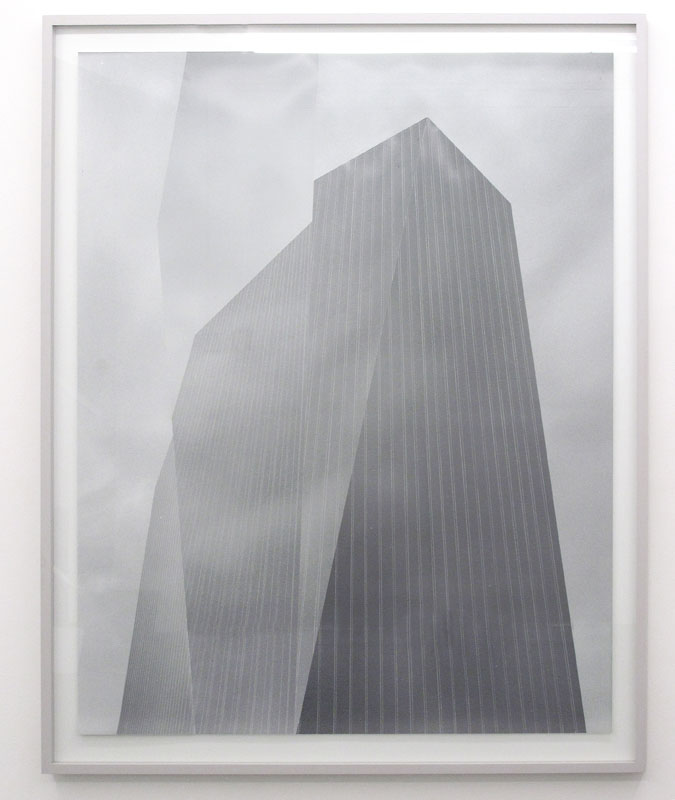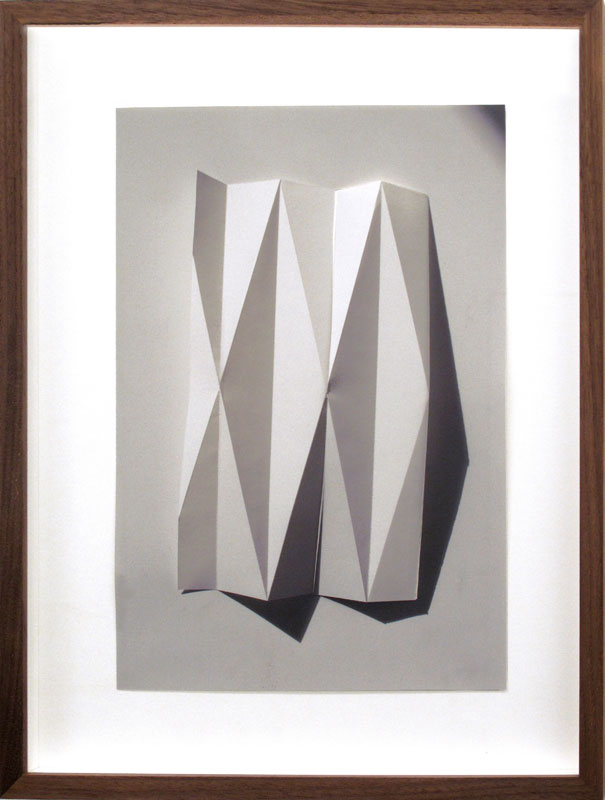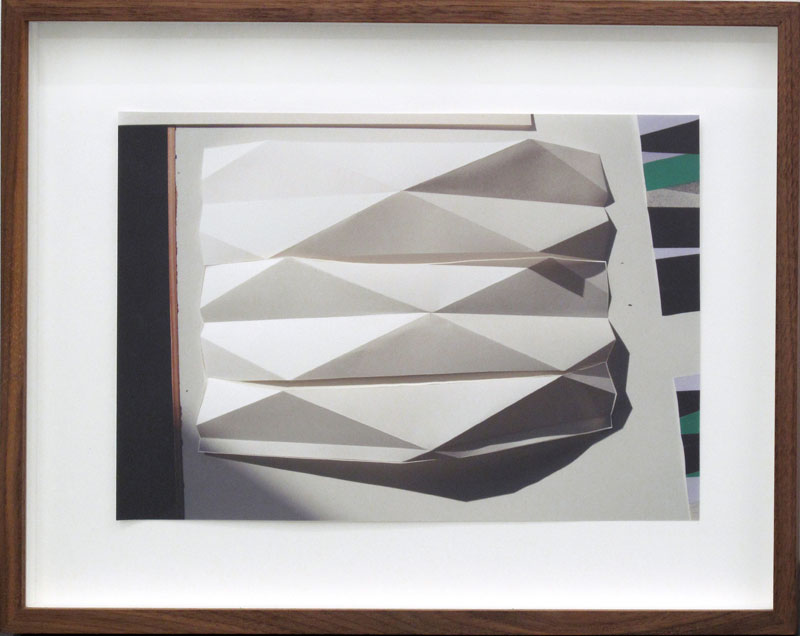| EXHIBITIONS NEWS PRESS ABOUT US CONTACT |
|||||
| REPRESENTED ARTISTS | BERTILLE BAK | GWENAEL BELANGER | DEXTER DYMOKE | ANTTI LAITINEN | |
| MARKO MAETAMM | YUDI NOOR | OLIVER PIETSCH | KIM RUGG | ||
| BETTINA SAMSON | SINTA WERNER | ||||
SINTA WERNER
"Setting the Setting”
26 OCTOBER - 1 DECEMBER 2012
II.jpg)
NETTIE HORN is pleased to present a solo exhibition by German artist Sinta Werner, featuring a group of site-specific works consisting of sculptural and print-based elements, shown alongside a wall painting and collage series. This entire body of work is developed around the concept of folding and doubling - as a primal process of dimensional shift.
Sinta Werner’s practice engages with the creation of experiences questioning the representation of space, predominantly through an exploration of the two and three-dimensional. From an initial focus on the materialisation of fictitious environments (as, for example, a mirrored or double-exposure space might represent it), to a recent exploration into the world of digital media and its virtual journey, Werner’s new body of work evolves from a reflection on the notion of representation itself.
All the works have in common that the image-support is at the same time the image-subject. The central piece 'Setting the Setting / Staging the Fake' consists of honeycomb-cardboard panels, staged like improvised architectural walls not yet in their final position. This arrangement has then been photographed, printed and mounted back onto the panels, so that shifts of perspective are evoked, and so that the surrounding architecture - i.e. the panels and images of the panels and exhibition space - are interlaced. Conceptually this work can be seen in the tradition of Joseph Kosuth's famous piece 'One and Three Chairs', which consists of a chair, a photograph of it, and it's dictionary definition. Whilst Kosuth had been splitting up the object into its semiotic layers, Werner’s interest lies in the object being split up into its dimensions, yet still being contained within one piece; and in the fragmentation, dislocation and shift in perception involved in this process. The honeycomb-cardboard panels (as well as the frames in the slide-object shown in the basement) have been selected as subject matter for their neutrality, and for functioning as mere extensions of the exhibition space, or display.
The site-specific photograph ‘Mise en Scène de la scène’ also suggests a situation - as if the installing of the show was still in process. Packing paper, which would normally protect the floor from paint, and string (which works as subsidiary lines for the wall painting), have become part of the piece - connecting a photograph of this display with its original elements. There is an aspect of fakery in this arrangement: whatever looks unfinished or arbitrary has in fact the theatrical aspect of a manipulated reality. This geometric pattern then reappears in the window piece and in the finished wall painting, themselves having their origins in the small collage works ‘Untitled (Folds Unfold)’. Here what appears like a 'mise-en-abyme' in the larger print, is finally a 'mise-en-abyme' running throughout the entire show. These collage works then close the circle of this theme of doubling, as they too are constructed from folded paper, which, simultaneously, also depict them.
The series of collages 'Discrete Folding' take a similar approach. Here sheets of paper have been folded, photographed, printed and then refolded according to their original state. Werner's collages and installations are often developed through this process of transferring back and forth between two and three dimensions. Existing architecture is another source of inspiration in Werner’s practice, such as in the collage series ‘Schattenfassaden’. In this series the architecture of socialist warehouses from the 1960’s form the origin of this photographic series. With these Werner initially made replica cardboard models of the buildings facades, photographed them in strong sunlight to create high contrast shadows, then cut into these photographic prints in order to fold them back into the same structure as the "original' replica model.
Existing architecture is also at the origins of ‘Scraping the Sky’ in which the materiality and gravity of the building is suspended. As the architectonic planes in the collage have been replaced by details of the sky, the reflective invisibility of the building is emphasised. The cut-out sections of sky feature as both construction and deconstruction, creating a geometrical space in which the sky appears separated from reality.
For inquiries regarding availability of works and prices, or additional information about the artist, please contact the gallery

Passing by (window piece), 2012
Print on paper

Installation view, Sinta Werner, Setting the Setting,
NETTIE HORN, 2012

Installation view, Sinta Werner, Setting the Setting,
NETTIE HORN, 2012

Inset, 2012
Acrylic paint on wall
302 x 290cm

Mise en scène de la scène, 2012
Print, wool string, nails
288 x 283 x 100cm


Schattenfassaden I, 2012
Photographic paper
52.5 x 63cm each

Schattenfassaden II, 2012
Photographic paper
52.5 x 63cm each

Schattenfassaden III, 2012
Photographic paper
52.5 x 63cm each

Schattenfassaden IV, 2012
Photographic paper
52.5 x 63cm each

Untitled I (Folds Unfold), 2012
Paper and acrylic paint
52.5 x 63cm / 33 x 38cm

Untitled II (Folds Unfold), 2012
Paper and acrylic paint
52.5 x 63cm / 33 x 38cm

Untitled III (Folds Unfold), 2012
Paper and acrylic paint
52.5 x 63cm / 33 x 38cm

Installation view, Sinta Werner, Setting the Setting,
NETTIE HORN, 2012

Scraping the sky, 2012
Photographic paper
125 x 147.5cm

Double reduction II, 2012
Large format slides, glass, wood & paint
75 x 45 x 60cm

Sinta Werner
Discreet folding I, 2012
Photographic paper
35.5 x 28cm

Sinta Werner
Discreet folding II, 2012
Photographic paper
35.5 x 28cm

Sinta Werner
Discreet folding III, 2012
Photographic paper
35.5 x 28cm
© NETTIE HORN